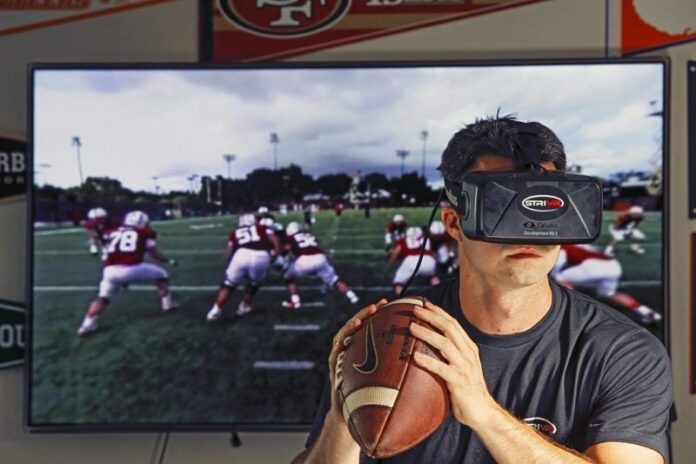The complexity of sports today demands critical thinking skills the industry didn’t rely on even a decade ago. The back office’s ability to manage talent by allocating players based on how they perform is crucial to a team’s success. Moneyball is an excellent example of this kind of thinking, the behind the scenes data crunching, which often goes on at the professional level.
Pro-level sports is a game of analysis and knowledge acquisition, as well as raw physical talent. Both AR and VR technologies are equipped to gather this data, while coaches and staff do the work of finding meaning.
Technology in Practice
The way coaches have to think about how to beat a team has changed dramatically. We can look at the 2000 NBA Finals, where Kobe Bryant’s dogged pursuit of Reggie Miller crippled the Pacers’ ability to create a play. Kobe spent summers playing one on one with Miller, downloading his playstyle over time.
Stanford and STRIVR look at this problem as something to be solved by technology. If you put athletes inside of advanced virtual reality training simulators, they have the same opportunities to learn and train for certain playstyles. STRIVR has one additional benefit: coaches can see from the player’s perspective. It’s no longer just the player’s responsibility to study, coaches can provide specific guidance to help an athlete’s reactions. Coaches no longer feel out someone’s instincts, they have a recorded session that they can point to and review with the player.
Using VR to record a session is helping coaches to work on the player’s subconscious game, teaching the player how to focus all effort on the play. The player can also re-run the same play far more times than in practice. In a four hour session, a star player might get 20-25 opportunities to run a play. On VR, any player can rewind and freely move through a play without physical exertion. This has massive implications for the mental game, without taxing the body.
[youtube https://www.youtube.com/watch?v=h9h89P3Yi9I&w=560&h=315]
If the athlete can train 100 sessions, physically performing 25% of those on the field, his longevity and endurance suffers no lasting damage as his mental capacity increases. If we can effectively improve learning and situational awareness without the toll on the body, simulation can augment practice. This isn’t pseudo science, it’s already working for professional teams like the Arizona Cardinals, which credit STRIVR with some of their best work. Carson Palmer calls it indispensable.
Data Crunching
[youtube https://www.youtube.com/watch?v=2Y6onCekt_8&w=560&h=315]
STRIVR is a unique kind of data collection. It’s not the numbers and percentages we are used to seeing, it’s an accumulated experience. It’s a lot like training in muscle memory, only the muscle being trained is the brain. So, what exactly does this kind of technology do for the athlete and how can the organization track improvements?
The most obvious benefit is improving reaction times, but players learn where to focus during a play. This kind of training is designed to highlight opportunities that were previously much harder to spot. STRIVR runs analytics for each player that uses the equipment, so players also have historical data on career performance. A player can see how he has improved in a certain play overtime or working with another player.
That said, there’s a lot of coaching that goes on, and the player has to be willing to learn along with the system. In Palmer’s case, going over the plays helped to cement the learning process and make it much easier to commit the playbook to memory.
What Teams Need Now
There are openings for entrepreneurs and bright minds who want to dive into this new realm of sports, and they really run the gamut in terms of experience. Those in IT are needed to set up these complicated systems, including PC builds and networking to record and share data. For a team like the Cardinals, which has the resources for this kind of infrastructure, data engineers are useful for parsing this collective data.
A data engineer helps take the raw data of a session and turn it into something a coach and player can read, like a report of what was done. Analytics are important for milestones and trajectory, so engineers who understand how to model this data are in incredibly high demand.
Final Thoughts

The complexity of sports is evolving on and off the field. Fan engagement relies on technology that conveys the game in new and exciting ways. AR is becoming a powerful tool in this engagement, capable of relaying real-time information and connecting fans to the game in ways that were never possible before.
AR and wearables also made an appearance at the winter Olympics. The Dutch skating team used the Samsung Smart Suit during practice to be made aware of their form on the ice. Coaches could quickly relay vibrations to skaters that would tell them how to move or how to position their bodies to improve speed and cornering.
There are certain applications for both of these technologies, but there’s an even more significant demand for those who possess the technical skills necessary to crunch this data.


